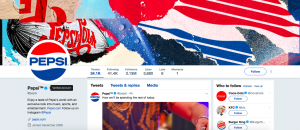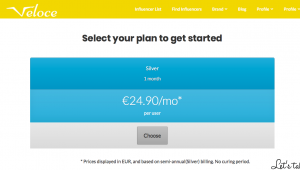Are you getting the most out of your social media marketing?
We all know that social media can help brands generate incredible marketing results.
As a result, more and more brands are hopping into social media and the marketing potential that can be tapped there.
When talking about social media marketing, we often talk about using clever strategies and launching successful campaigns, but something that is often neglected in today’s social media marketing landscape is social media optimisation.
And when I researched topics to write about to help you succeed with social media, it struck me that while social media optimisation is tremendously important, there are relatively few people talking about it, and more importantly, there are few posts that cover all areas of social media optimisation and how you can use it to succeed.
And if you know me, you know that I want to help you get that leverage over your competitors which helps you dominate in your industry, and that’s exactly what social media optimisation and this post about it will help you do.
What is social media optimisation (SMO)?
Let’s start with the foundation.
What is even social media optimisation?
Well, Social media optimisation, or SMO has been referred as the “next wave of online marketing”, and it is a marketing tactic that is all about using social media, and then making changes and improvements to your social media marketing strategy which will help you improve your site’s search engine rankings and traffic.
And if you are working with search engine optimisation, you know that this, in turn, will lead to new prospects, and new potential clients coming to your website.
Some tactics that are used in social media optimisation are indirect tactics used to help you improve your site’s position in search results, and therefore help you generate more business, and some tactics are more direct, focusing on boosting your traffic, and in that way get new customers. An indirect benefit might come from an extra link that points to your site, and a direct might just be that you make your brand more visible to people, and therefore gain traffic.
As such, you can call social media optimisation a marriage between search engine optimisation (SEO) and social media, which is used to drive you more sales and business. This means you leverage social media as a marketing tool, which will help support your goal of driving more business with the help of your website.
When working with social media optimisation, you are working with two search engines in mind.
Firstly, you have the search engine within each social media platform you’re using, and secondly, you have Google search, together with all of the other search engines.
Social media has the attention of users – a lot of it. And this is the reason why more and more bands have started to leverage social media marketing. And by using social media, you can extend your reach to connect with new people, prospects of your business, which drives you benefits not only in the form that people might buy from you, but also that you increase the awareness of your brand, and thus increase the opportunities that your website will have, mainly through SEO benefits.
But remember, though, the word optimisation essentially stands for making the best of what you have and the situation in, and therefore, it’s not all just about focusing on how you can use social media to gain more links or to get more press coverage.
It’s about evaluating your social media strategy and usage, and looking at the things you can do to improve all areas of it. It’s also about getting prospects to find you, helping them get from point A to B, and then providing them with value so ultimately, they buy from you.
Got it?
So while the word optimisation is focused on search engine optimisation (and often confused to be the exact same), the world of social media optimisation is a world that is much greater than that. A reason that they are sometimes mixed up is that all marketing benefits often have SEO benefits in one way or another – directly, or indirectly.
This can be an increased awareness which means more links, or simply more traffic and branded searches.
Now, you probably realize that social media optimisation isn’t something that deserves to be at the very bottom of your ”to-do” list, but am I reading your mind if I say that you are probably wondering in what ways it is important?
Here are 4 reasons why you need to pay attention to social media optimisation:
Increases chances of SEO benefits
There are tons and tons of SEO benefits that can come with social media optimisation, and this is also the reason why social media is at the center of attention when it comes to SEO – at least in this post.
Firstly, search engines have admitted that they have started paying attention to the things happening on social media and that they index social media just like all other pages. Google has also reported that they will probably use social media as a ranking factor in the future.
And this makes sense considering the fact that there are about 2.77 billion social media users in the world, who spend an average of 135 minutes on social media.
In other words, social media is for search engines something getting increasingly difficult to neglect.
Your website is reliant on people for ranking and gaining traffic, and when people spend so much time on social media, it becomes a perfect place to meet them.
When more people know about your website and brand. you’ll gain more branded searches (which are indications to Google), you’ll increase your chances of gaining links, and you increase the chances of having people talk about and mention your site.
Build a strong presence on the web
Where people are, you should be, too, and with the help of social media optimisation, you can establish yourself as a leader in your industry and build a strong web presence for your brand. Doing this comes with a number of marketing benefits such as brand awareness, branding, recall, and ultimately more traffic.
More traffic
Today, the website is for most businesses the heart of the business, the gathering point for customers, and a conversion point for the brands.
When you get people to your website, you have brought them a great distance down your conversion funnel, and the good news is that social media is a great tool for increasing traffic, and with social media optimisation, you can tap your full potential and make it even better.
Increase your reach
Ideally, you would want to be in touch with every single potential customer of your brand that is, but that’s impossible.
But what you can do, however, is be in the places where your target audience is spending time, and engage with them.
As we know by now, there’s a lot of people on social media, and equally so, there’s probably plenty of your prospects there.
For your website and business, social media becomes like an additional fishing net for your brand, with which you can catch more customers, and reel them into your website, to gain you marketing benefits.
With social media optimisation, you can reach a larger number of people, and you can reach out to your audience at the places where they are spending time.
Now, let’s dig into these 12 ways to do social media optimisation to drive you more business.
12 clever social media optimisation tactics
Similar to SEO, social media optimisation can be divided into off-and on-page optimisation. On-page optimisation includes things like optimizing the content you share and how you share it, and off-page optimisation is more about using social media as a tool to help you gain SEO benefits, for example, generate links to your website.
1. Create consistent branded URLs
Having consistent URLs for your brand might seem like a minor detail, but when it comes to social media optimisation, it is the details that matter.
For discoverability and brand recognition, you want to try to keep your usernames consistent across all your social media platforms.
If it isn’t possible to have identical usernames across your social media accounts, you want to have a username that is as close to the original as possible. You also want to try to make the username as easily memorable as possible, as well as leave out any unnecessary dots, underscores or numbers, which can decrease recall and make it more difficult for people to find you.
To create a custom URL for your brand’s Facebook business page, go to the “About” section of your profile. Here, you can edit or create your branded username.
LinkedIn business page
LinkedIn creates URL slugs in the following format: http://www.linkedin.com/company/companyname, and therefore, the most ideal is to have your brand’s name as your business page’s username. Doing this ensures that it is easy for people to find you when searching, but also helps you stay more consistent.
Twitter automatically creates a URL which is based on the username you choose, so therefore, you should try to have the same username as your Facebook page and vice versa.
2.Optimize your posting times
The time of which you share a post is an aspect that is sometimes neglected.
Marketers might post on social media whenever they feel like it without any research, and doing this keeps the post from reaching its true potential.
Sure, it is true that with the new algorithms that have been introduced to the different social media platforms, the time of which you share a post isn’t crucial for a post’s success, but it is the small details which the word ”optimisation” lies in.
Now, if you’d asked me a few years ago when the best times to post on social media is, I’d blindly present some statistics that prove ”the best time to post”, but partly because social media has changed, and partly because I have learned a lot about social media, I can say that there isn’t an ideal ”best time to post” for everyone.
The idea with carefully selecting the time you post on social media is to post at a time when most of your followers are awake and online, and for obvious reasons, that time of the day isn’t the same for everyone.
Therefore, my best advice for you is to experiment. Many social media platforms also have analytics where you can see when your followers are most active.
Sharing at the right time on social media is almost like writing the headline for your post.
You might have put a ton of work into the post, but if the headline is terrible, then the post’s success will probably be equally so.
3. Optimize Your Strategy
Your social media marketing strategy lays the foundation to all your efforts on social media, and when it comes to social media optimisation and improving something, it’s always a good idea to start at the foundation. Because without a solid foundation, the whole construction will fail.
Some marketers neglect the social media marketing strategy completely, and that means setting yourself up for failure. And if you have a strategy in place, it might need some optimisation.
The foundation for a successful social media marketing strategy is having clear goals for your efforts.
If you’re a team working with your social media, it is crucial that everyone on board knows exactly what you are working towards, and then make every decision and action based on those objectives.
If everyone has different perceptions of what your goal is, the previously mentioned thing will happen which is that you’ll all pull in different directions, preventing you from getting somewhere.
Now, the strategy might feel like a waste of time and that is better to just go out and do it, but a study found that Twenty-eight percent of brands feel that a lack of strategy is the top barrier keeping them from using social media.
In order to optimize your social media marketing campaigns, you have to have a strategy with clearly defined goals and objectives.
What’s more, social media optimisation is all about making small changes which make huge improvements. This includes improving the things that work less well, and cutting out the things that aren’t working at all, or are straight up hurting you.
But the problem that comes with not having a strategy, not having an optimised, or not looking at it, is that it will be hard for you to evaluate your results.
If you haven’t set any clear goals, how can you know if you’ve achieved them, or come closer to them?
By using social media optimisation to optimize your strategy, you’ll be able to identify key areas where you can improve, and thus allow you to generate better results in the future.
4. Complete and optimize your social media profiles
The most simple thing, I know, but I am staggered at how many businesses haven’t completed their social media profiles, and it is hurting them tremendously.
What do you think people will think if they see a half-done storefront out town?
They’ll probably think that the business hasn’t opened yet, or that it is closing.
Your social media profiles are for most people the first interaction they have with your brand, and therefore, you need to ensure that it is completed and as appealing as possible.
A completed profile can be the difference between getting a prospect to visit your social media page and then click through to your website, or see your profile and leave.

Begin by filling in your ”About” section with all relevant and important information. You want people who have never heard of your brand before to know exactly what you are about after reading it. Remember that your about page might be the first encounter people have with your brand, and how it looks and what it contains can be the difference between a lifelong customer or someone you’ll never hear from again.
When optimising your about page, you also want to sprinkle it with relevant keywords when appropriate, in order to make your profile discoverable in search.
Moreover, include things like contact information, location, office hours, other relevant information, and maybe most importantly, your website so people can learn more about your brand.

Remember that your social media profiles can come up in search results, and this means more business opportunities for you, so don’t let this opportunity go to waste.
Also, don’t forget to add a profile picture (yes, some brands still forget this). If you’re a brand, your profile picture should be your logo, and you should have it consistent across all your social media pages for consistency and discoverability. If you’re building your personal brand or have a page that’s circulating around you as an individual, you should have a headshot.
5. Create custom Facebook apps on your page
Did you know that Facebook allows businesses to create and include customized apps in their profiles?
Well, they do, and if you aren’t using them, you’re missing out on tremendous opportunities. It is a small profile optimisation tactic that can make for huge differences and drive a ton of traffic.
6. Pin content to the top of your profile
Many people don’t know this, but several social media platforms, including LinkedIn and Twitter, allows you to pin content to the top of your profile so that people who visit your profile won’t miss it.
If you share something on social media, it will quite quickly get pushed down in your feed to the point where no-one can find it.
But if you have an important announcement or something that you don’t want people to miss, the pinning feature is extremely effective and helpful.

Pinning allows you to cram out every piece of marketing juice from your content, and not just have it disappear among all the other content that you’re sharing.
7. Leverage strong call-to-actions
If you aren’t using calls-to-action in your social media posts, you’ll be surprised at how big of a difference they make.
When Social Times added social media sharing buttons to its emails, the result was a 158% increase in CTR. Safe to say, optimisation through small changes and improvements can make a huge difference.
And frankly, that’s what social media optimisation is all about.
If you’ve gotten people’s attention on social media, you’ve already surpassed the most difficult point. Now, you want to leverage the attention you have to get them to do something. This can be everything from visit your website to simply tagging a friend.
When you want your audience to do something, your goal is to make that process of doing as simple as possible. Ideally, people should have to think about what they should do, you should tell them.

A feature on Facebook you don’t want to muss out ones the CTA button which you can add on your cover photo to help you with conversions and getting people to take action with your business.
8. Leverage the power of visuals
Now, several social media are completely or to a large extent solely focused on visual content, and this means you have little choice to use them.
But the thing is, you want to use visual content as much as possible in your social media marketing.
Why?
Humans are visual creatures and resonate a lot better with visual content than text:

What does this mean?
It means that with visual content, you have the ability to impact your audience far greater than with text. And remember, as a business, your goal is to impact your audience deeply, because itis only when you do that that you can get them to tact action – whether it be to buy from you or visit your website.
If you aren’t yet using visual content, now is the time to start using them, and if you aren’t using them as much as you want to, now is the time to optimize your content strategy to include more visual content.
A study found that research shows posts that included relevant images generated 94% more views than those without.
Include visual content as much as you can where it makes sense.
9. Optimize Your Content
Content is king.
This goes for all aspects of marketing. Including SEO.
Since content lays the foundation for both SEO and your social media marketing, a natural part of your social media optimisation is obviously to look at, and optimize your visual content.
If you don’t have content on social media, you have nothing. The content you share is your value proposition and ultimately what will attract and impact people. And it has to be high-quality.
Now, I’ve already gone through the importance of visual content, and that’s a major deal.
But there is more to your content than just visual content. Plus, just because you use visual content doesn’t mean that they’ll generate great results.
For all I know, they might be blurry and boring, right?
Since creating appealing content is an art and there’s a lot to think about, I’ll leave you with this complete guide to creating visual content because otherwise, we’d be here all day.
10. Track and measure results
An important part of social media optimisation is your social media strategy. And an important part of your social media strategy is your objectives.
By having clear goals and objectives, you know exactly what your want to achieve, and when you want to achieve it.
Naturally, tracking and measuring results becomes a natural part of that. When you’ve completed the timeframe that you’ve set, you want to evaluate and ensure how well you have performed, and what results you’ve generated.
Have you reached your goals? Have you exceeded your goals above and beyond?
Have you generated worse results than expected?
Unless you evaluate and measure your results, it is impossible to know where you are and how your social media presence is going, and even if you’re working in the right direction.
Through evaluation, you know exactly how you have performed, and then with social media optimisation, you take a look at the things you can do to make it even better.
Here’s where goal-setting and evaluation complements each other and helps you run a social media marketing campaign that is successful, because if you don’t have goals, it is impossible to measure results, and if you don’t measure results, you’ll never know if your actions are helping you advance in the direction you want to advance in.
In social media optimisation, tracking and measuring results is foundational for making any improvements, and it is not until you’ve evaluated you can start thinking about potential optimizations and improvements. But obviously, if you don’t do anything, you aren’t optimizing, and thus, you won’t generate better results. This is why the improvements you come with are equally, if not more important than just measuring results.
11. Keyword Research
If you’ve been working with SEO, you know that keyword research is a huge part of all successful SEO efforts.
In case you’re unfamiliar with keyword research, it is essentially the process of identifying keywords your target audience is searching for and talking about in order to craft content that is focused on those topics and answering the questions people have related to those topics.
Keyword research is not only important for creating blog posts or website pages which ranks well on Google for specific keywords, but it is also important for knowing what topics your audience care about so that you can provide them with content on social media that is related to those topics.
Doing this will also allow you to use relevant hashtags which your audience is searching for and using, thus increasing your visibility and exposure to the people who matter the most to your brand. Hashtags are a major deal on social media, and they are especially powerful on platforms like Instagram.
Using the right hashtags can dramatically increase your reach, and studies have found that posts with hashtags perform a lot better than those without.
But in order to see that success, you need to identify keywords (hashtags) your target audience is searching for, and one might can this a type of keyword research.
But you don’t want to just target the most popular hashtags, similar to keyword research in SEO.
Just because a keyword has a ton of searches on Google doesn’t mean you go after that keyword, because the people who are searching for you are probably not relevant to your brand.
Instead, you focus on relevancy and using the keywords your audience is using.
12. Optimize headlines
Headlines are incredibly important for successful posts, and there are two aspects of successful headlines on social media.
Firstly, you need to have an engaging and attention-grabbing headline which gets people engaged, and secondly, you need to ensure that you’re not using the same headline over and over again when seeing our your Facebook posts or your tweets.
By switching your headlines up and coming up with new ones, you ensure that your content is fresh and unique, and it also allows you to discover the types and formats that work the very best.
If you share the same things over and over again, people will get bored, and they’ll eventually leave you.
Conclusion
The social med9dia marketing landscape has evolved quickly in just a few years.
While, back in the days, you could just share a few posts and then wait for the marketing results to roll in, if you do that today, you’ll drown in the saturated landscape of social media, and you will definitely not generate any results worthwhile.
To beat your competition and stand out from the crowd, you must learn how to use social media as a marketing from all aspects you can possibly think of, and that includes social media optimisation.
It is a tactic that few are using, but that has proven to be effective, so start using it, and see it as your secret weapon.


